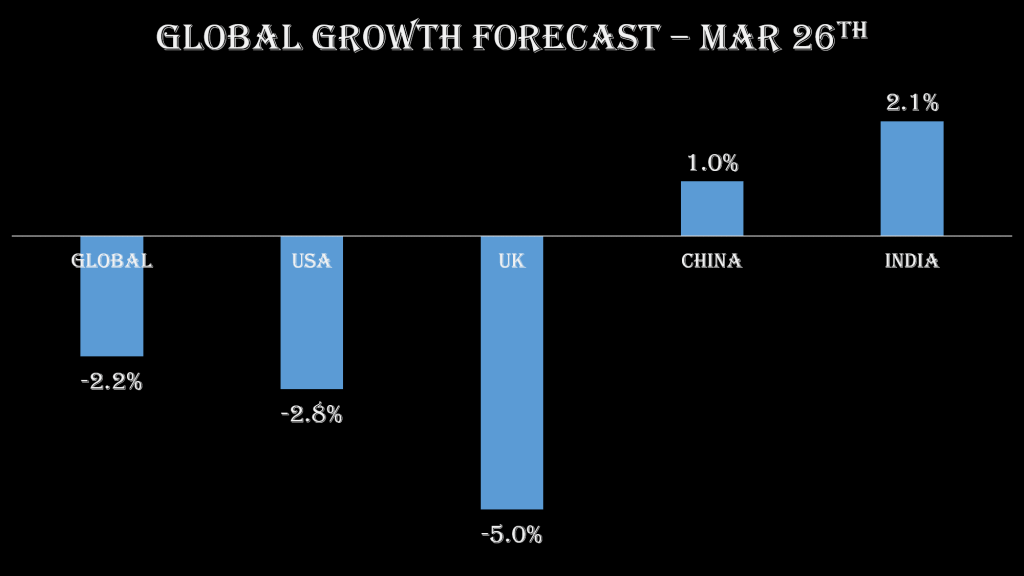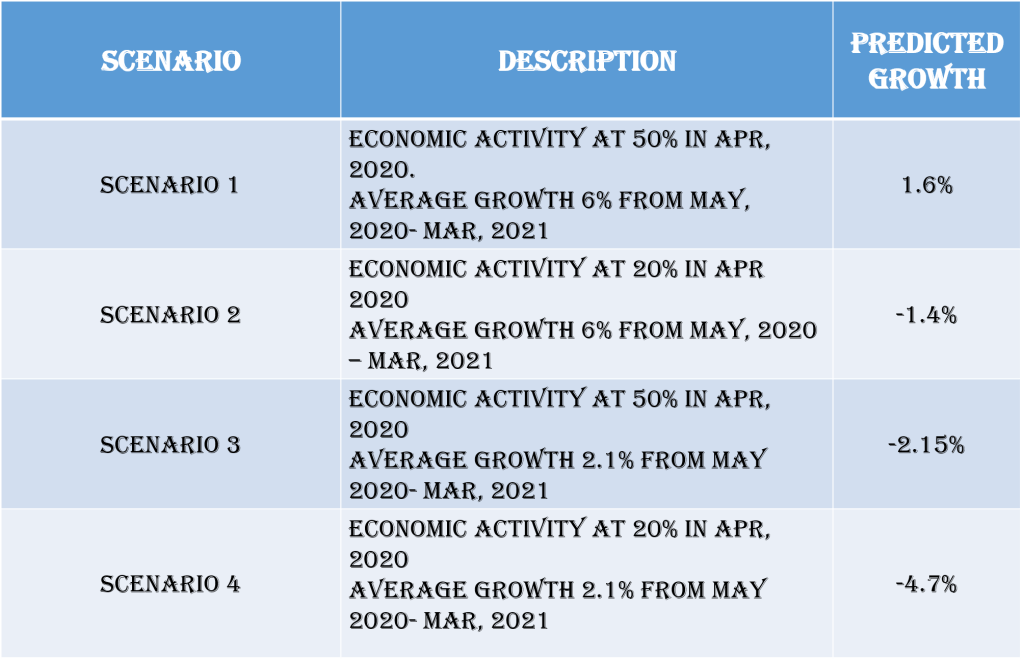The entire world is severely impacted by COVID 19 with over 1.7 million people affected till now and there have been over 1 lakh deaths by now. This has been one of the most severe pandemic situation the world has faced in over 100 years. This has impacted all the continents of the world. Many countries have gone into complete lock down to control the spread of this deadly virus. The only pandemic which had close to this impact is in 1918 when there was a spread of Influenza virus across the world.
A lot has been discussed on what is going to be the economic impact of this pandemic given the world has almost gone to a standstill. The situation is changing day by day with no respite in site. Any prediction at this point is difficult as the effect of Corona is still very much strong and there is no clear indication on how this can be controlled. With the changing situation the predictions made even a week back does not really hold true even in 7 days time.

The Economic Intelligence Unit (EIU) came up with growth rate prediction for G20 countries on 26th March. So the calculations have been done before that. As per the estimate the global growth is going to shrink by -2.2% in 2020. India and China have been shown to have a positive growth with the growth numbers of India pegged at 2.1% as against the earlier projection of 6%.
A lot changes have happened since then. India has gone into an unprecedented lock down for 21 days and which is most likely to be extended for another 15 days. China which had seen some improvement again saw new cases of Corona virus. The impact on USA has become worse with over 5 lac people affected by Corona. Many other countries have also gone for lock down. Given this scenario the situation has become worse than on 26th March and the global growth estimate would have shown more dismal picture now.
Some scenario analysis on Indian economy throws some light on what can be the impact of this lock down and the pandemic scenario in the economy. However as discussed the situation can change drastically depending on the spread of the disease. The scenario analysis is explained below.

It was announced that the essential services will be on during the lock down. Also it has been assumed in all scenario that the lock down will not be extended more than 1 month. The best case scenario is that during lock down, 50% of economic activity will continue to function and the economy will grow on an average at 6% ( pre corona projection of EIU) from May, 2020 to Mar 2021. Given this conditions simple calculation show that the growth rate of India will be around 1.6% in FY , 20-21. This is a low probability scenario as given the pandemic in the entire world it is highly unlikely that the economy will grow at an average of 6% in the post corona period.
The worst case scenario as of now assumes that economic activity will decline by 80% with only 20% of the economy functioning in the lock down period and in the post corona period, i.e., from May 2020-Mar 2021, the average growth will be 2.1% ( EIU projection as of 26th March) Given this scenario the Indian GDP will shrink by 4.7% and will go into a state of complete recession. If the lock down continues further and / or the rest of world continues to fight with this pandemic for long then the situation can be even worse than the worst case scenario as of today. The two intermediate scenarios also show negative growth for FY 20-21.
Sector wise Impact
A lot has been discussed on how this Covid 19 will impact different sectors of economy. IPD analyses the situation and possible impact for some of the sectors.
Agriculture Sector: This is the most people intensive sector in India. The major challenge faced by the farmers today is that this is the harvesting season for Rabi crops like wheat, paddy, mustard, pulses and so on. Lock down means delay in harvesting which can lead to decay of the crop and therefore, can be a huge loss. Even if they are able to harvest, it will be a huge challenge to sell the crops in the mandi in this situation. Both of these can cause a huge loss in the agricultural sector.
Construction Sector: This is one of the most people intensive sector after agriculture. With the migrant labours being forced to go back to their native places as there is no work during lock down, this sector faces a huge challenge and can take over months to show some recovery. Moreover with the prediction of recession, there is a huge chance of declining demand in this sector.
SME/MSME Sector: Along with the construction sector, this is one of the most people intensive sector and rely very much on migrant labours. Moreover many of the units rely on raw materials from China and will face a huge challenge with the impact of Corona there. Additionally, this sector faces huge loss with zero production and the establishment cost. This can lead to huge erosion of working capital and many of the entities in this sector might be forced to take loan. This sector already has been under severe debt and was facing challenges even in the pre-corona period. Moreover the impact of possible recession can further cause damage to the growth potential of this sector. There is a risk of job loss in this sector at least in the short run.
Travel and Tourism Sector: This is going to be one of the most affected sectors with huge curb on international as well as domestic travel and this can continue for almost the entire year. Aviation industry and hotel and hospitality business will be severly impacted by this. Many Indian states mainly rely on tourism and they are going to be badly impacted by this.
IT Sector/ Outsourcing Sector: A lot of Indian youths get placed in IT sector every year and mainly serve US and European markets. With the fear of possible recession in the whole world with US and Europe being the most severely impacted and also due to the huge restrictions on travel, there is a chance of loss of work for many Indian IT professionals who are working in the western countries. This has a potentiality to cause massive job loss both in short and long run.
The impact on unemployment will be severe. CMIE estimates show that the unemployment rate stood at 23% as of first week of April. Moreover many of the multi national companies and big corporate houses are going on freeze in hiring and also job cut or salary cut or no hike for this year in order to sustain this impending recession. The Indian economy is very much dependent on the services sector. Each of these actions by big corporate houses will have a massive impact in the economy.
Way Out
A lot has been discussed on what is the way out from this situation. If one looks at history, the only situation which can be drawn parallel to the present pandemic scenario and its potential impact in the economy is the time of The Great Depression in the 1930s. The major policy prescription that helped the world come out of that state is huge fiscal stimulus. The prescription given by Keynes of increasing government expenditure in this situation is the only way out in the short and the medium run.
For India, the need in this lock down period is to provide the huge section of people who have lost their income with food and basic needs for sustainability. There are two possible ways in which the Indian government can provide the necessary support to the entire population. One is direct money transfer in people’s bank account and the other is to provide them with food grains. The optimal solution is perhaps a mixture of both. First of all support both in the form of money or food grains need to be provided to all without focusing on specific criteria like whether they have certain PDS card or not or whether they have Jan Dhan account or not and so on. There should be a blanket transfer of money ( in cash or in the form of food grains or a combination of both) to all. The Indian government has announced a package of 1% of GDP for this purpose. But this is not enough. There should be at least a fiscal stimulus of 4-5% of GDP. The US government has announced a package of 10% of their GDP.
Extra ordinary crisis demands extra ordinary prescriptions. The US government started the social security schemes for elderly and unemployed in the aftermath of the great depression. A Universal Basic Income scheme can be a possible policy prescription for India.
The farmer needs to be provided opportunities to harvest Rabi crop and this can be brought from the farmers at their door itself. They should be guaranteed for at least the minimum support price. At this point the Food Corporation of India’s godown has over 77 million tones of food grains. With additional food grains provided as per government policies as of now and also the need of providing more as has been discussed above, the government can buy the Rabi crops from the farmers given the Mandis will be closed due to lock down.
In the medium and long run more work needs to be generated through the MGNREGA scheme in order to employ more people who loose work in the agriculture and construction sectors. Many small infrastructural projects in collaboration with private enterprises or with NGOs need to be undertaken.
Moreover specific packages needs to be given for the MSME and SME sectors and a thorough focus should be there on this sector. RBI has announced a decline in Repo rate and Cash Reserve Ratio implying more money in the hands of the banks which can be lend out to this sector. There should also be considerations of relaxation on interest payment if the lock down period is increased further. The central bank has announced moratorium for 3 months. However a closer look into the policy implies more burden on the borrowers.
The task of reviving the economy is challenging and it needs to be seen how the situation unfolds in days to come. However in the long run perhaps a rethink on the present development strategy of over reliance on few urban cities and the services sector in general needs to be looked into. More focus on the tier two and three cities and rural economy and in terms of the sectors increasing focus in the manufacturing sector is perhaps the long term prescription.
New Tsunami is Coming After Covid19 allover
We have to prepare the consequences
Debate is Who will sustain Nature or Himan
Ss many stages of Covid may comes unwards in the Bio n camical war Oriented World
LikeLike
Nice Initiatives
LikeLike
First and foremost priority is that food industries and agriculture sector needed to be started with restrictions of social distance and regulations so that pandemic Corona can’t spread during this period. It’s very important to feed the nation and use of agricultural workers and labour class. The may get a base spirit to gear up economic growth and same way to start other industries .
LikeLike